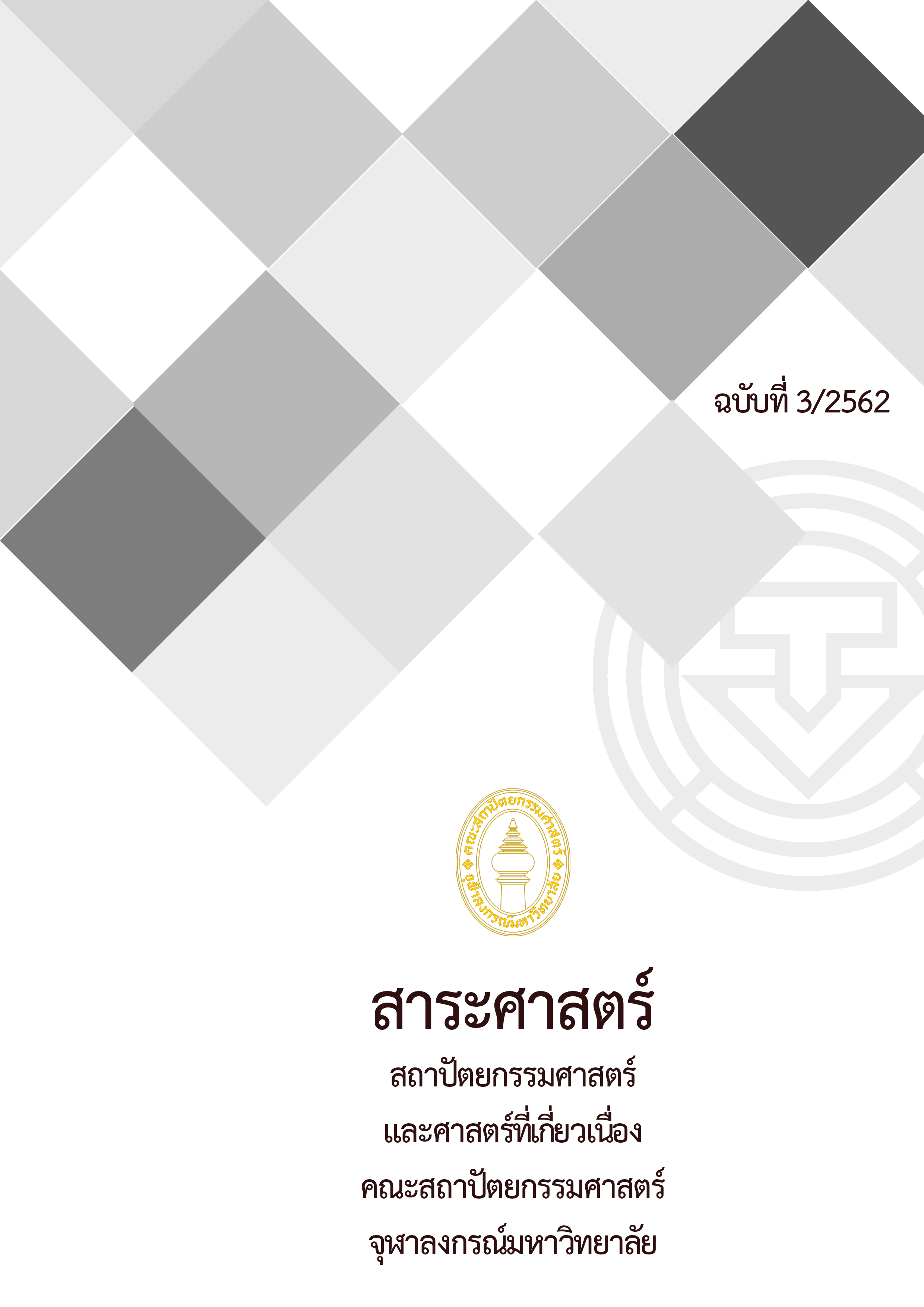ทัศนคติของผู้อยู่อาศัยต่อลักษณะคอนโดมิเนียมที่ส่งเสริมสุขภาวะในการอยู่อาศัย
Main Article Content
บทคัดย่อ
ปัจจุบันการคำนึงถึงสุขภาวะในการอยู่อาศัยเป็นสิ่งจำเป็นโดยเฉพาะการอยู่อาศัยในคอนโดมิเนียมซึ่งเป็นที่อยู่อาศัยที่ผู้อยู่อาศัยให้ความสนใจและมีแนวโน้มเลือกอยู่อาศัยเพิ่มขึ้นต่อไปในอนาคต งานวิจัยนี้มีวัตถุประสงค์เพื่อศึกษาทัศนคติของผู้อยู่อาศัยต่อลักษณะคอนโดมิเนียมที่ส่งเสริมสุขภาวะในการอยู่อาศัย รวบรวมข้อมูลจากผู้อยู่อาศัยในคอนโดมิเนียมจำนวน 131 คน โดยใช้วิธีการแจกแบบสอบถาม วิเคราะห์ข้อมูลด้วยสถิติเชิงพรรณา (Descriptive Statistic) และวิธีการทางสถิติ
จากการสำรวจลักษณะทางสังคมของกลุ่มตัวอย่างพบว่ามีสัดส่วนของเพศหญิงมากกว่าเพศชาย (ร้อยละ 65.6) และอยู่ในช่วงอายุระหว่าง 21 - 30 ปี (ร้อยละ 36.6) ส่วนใหญ่อยู่อาศัยจำนวน 2 คน (ร้อยละ 44.3) ระยะเวลาอยู่อาศัย 1 - 2 ปี (ร้อยละ 43.5) ใช้เวลาในการเดินทางจากคอนโดมิเนียมถึงสถานีรถไฟฟ้าที่ใกล้ที่สุด 5 - 10 นาที (ร้อยละ 39.7) เป็นเจ้าของและมีกรรมสิทธิ์แบบซื้อขาด (ร้อยละ 61) อยู่คอนโดมิเนียมที่มีความสูงมากกว่า 8 ชั้น (Highrise) (ร้อยละ 71.7) ประเภท 1 ห้องนอน (ร้อยละ 45) ผลการศึกษาพบว่า 1) ความพึงพอใจเรื่องสุขภาวะในคอนโดมิเนียมอยู่ในระดับปานกลางถึงมาก (ร้อยละ 75.6) โดยอายุต่ำกว่า 20 ปี มีค่าเฉลี่ยอยู่ในระดับพึงพอใจมากที่สุด (4.27 คะแนน) และมีค่าเฉลี่ยความพึงพอใจมากในการอยู่อาศัยแบบครอบครัวใหญ่ในห้องใหญ่ ทั้งนี้จากการใช้สถิติพบว่าทุกปัจจัยที่แตกต่างกัน มีความพึงพอใจต่อเรื่องสุขภาวะในคอนโดมิเนียมไม่แตกต่างกัน 2) องค์ประกอบของลักษณะคอนโดมิเนียมที่ส่งเสริมสุขภาวะในการอยู่อาศัยตามทัศนคติของผู้อยู่อาศัยสามารถจำแนกได้ 8 ประเด็นหลัก ได้แก่ (1) คุณภาพอากาศ (2) ความสะดวก (3) สุนทรียภาพ (4) สภาวะน่าสบาย (5) การจัดการชุมชน (6) ความปลอดภัย (7) จิตใจ (8) ลักษณะทางกายภาพ
ผลการศึกษาชี้ให้เห็นว่า ผู้อยู่อาศัยมีความพึงพอใจเรื่องสุขภาวะในคอนโดมิเนียมที่อยู่อาศัยในปัจจุบันในระดับปานกลางถึงมาก โดยผู้อยู่อาศัยอายุน้อยจะมีค่าเฉลี่ยความพึงพอใจมากกว่าผู้อยู่อาศัยที่มีอายุมาก และคำนึงถึงลักษณะของคอนโดมิเนียมที่ส่งเสริมให้เกิดสุขภาวะทั้งในด้านกาย จิตใจ สังคม และปัญญา โดยผลการศึกษานี้จะเป็นประโยชน์ต่อผู้ประกอบการ รวมถึงภาครัฐและหน่วยงานที่เกี่ยวข้องในการพัฒนาคอนโดมิเนียมที่ส่งเสริมสุขภาวะในการอยู่อาศัยต่อไปในอนาคต
Article Details
เอกสารอ้างอิง
มาตรฐานความอยู่สบายของที่อยู่อาศัยและชุมชน. กรุงเทพฯ: จุฬาลงกรณ์มหาวิทยาลัย, 2560.
“ความหมายของสุขภาวะ.” สืบค้น 20 พฤศจิกายน 2561. https://preaw03.blogspot.com/.
ชัชวาลย์ เรืองประพันธ์. สถิติพื้นฐาน: พร้อมตัวอย่างการวิเคราะห์ด้วยโปรแกรม Minitab SPSS/PC+ และ SAS. ขอนแก่น: ภาควิชาสถิติ คณะวิทยาศาสตร์ มหาวิทยาลัยขอนแก่น, 2539.
ชุลีกร ทองจับ. “ทัศนคติและความพึงพอใจรวมของเจ้าของห้องชุดต่อการบริการการบริหารงานและสภาพแวดล้อมของรัตนโกสินทร์ไอส์แลนด์คอนโดมิเนียม.” สารนิพนธ์บริหารธุรกิจมหาบัณฑิต สาขาวิชาการตลาด มหาวิทยาลัยศรีนครินทรวิโรฒ, 2547.
นฤพนธ์ ไชยยศ. “ปัจจัยที่มีผลต่อความพึงพอใจของผู้อยู่อาศัยแนวตั้งในกรุงเทพมหานคร.” การประชุมวิชาการระดับชาติ
มหาวิทยาลัยรังสิต ประจำปี 2559 วันที่ 29 เมษายน 2559.
ประเวศ วะสี. “สุขภาวะที่สมบูรณ์.” นิตยสารหมอชาวบ้าน 351 (2551).
ปุณญารัตน์ เด่นไตรรัตน์และธีระวัฒน์ จันทึก. “ปัจจัยที่มีอิทธิพลต่อผู้บริโภคในการเลือกซื้อคอนโดมิเนียมแบบโลว์ไรส์ในเขตภาษีเจริญ.” Veridian E-Journal Silpakorn University ฉบับภาษาไทยสาขามนุษยศาสตร์ สังคมศาสตร์และศิลปะ 10, 3 (กันยายน-ธันวาคม 2560): 853-867.
“พัฒนาคุณภาพการอยู่อาศัย พัฒนาสังคมไทยยั่งยืน.” สืบค้น 1 พฤษภาคม 2562. https://www.thaihealth.or.th/Content/14151.
ภาวดี ธุรวงศ์. “การพัฒนาเกณฑ์การออกแบบอาคารเชียวเพื่อส่งเสริมสุขภาวะสำหรับอาคารที่พักอาศัยแบบยั่งยืนในประเทศไทย.” วิทยานิพนธ์ปริญญามหาบัณฑิต คณะสถาปัตยกรรมศาสตร์ จุฬาลงกรณ์มหาวิทยาลัย, 2559.
ราชบัณฑิตยสถาน. พจนานุกรมศัพท์สถาปัตยกรรมศาสตร์ ฉบับราชบัณฑิตยสถาน. กรุงเทพฯ: ราชบัณฑิตยสถาน, 2554.
ศูนย์วิจัยกสิกรไทย. “แบบสำรวจการศึกษาถึงทิศทางของตลาดและความต้องการที่อยู่อาศัยในช่วงระยะเวลาที่เหลือของปี 2549-2551.” สืบค้น 1 พฤษภาคม 2562. https://www.newswit.coni/news/.
สุดารัตน์ รักบำรุงและศรัณยพงศ์ เที่ยงธรรม. “ปัจจัยที่มีผลต่อความพึงพอใจของผู้อยู่อาศัยในคอนโดมิเนียมในเขตกรุงเทพมหานคร.” การประชุมทางวิชาการ มหาวิทยาลัยกรุงเทพ 2552.
สุวิมล ว่องวาณิชและนงลักษณ์ วิรัชชัย. แนวทางการให้คำปรึกษาวิทยานิพนธ์. กรุงเทพฯ: ศูนย์ตำราและเอกสารทางวิชาการ คณะครุศาสตร์ จุฬาลงกรณ์มหาวิทยาลัย, 2546.


